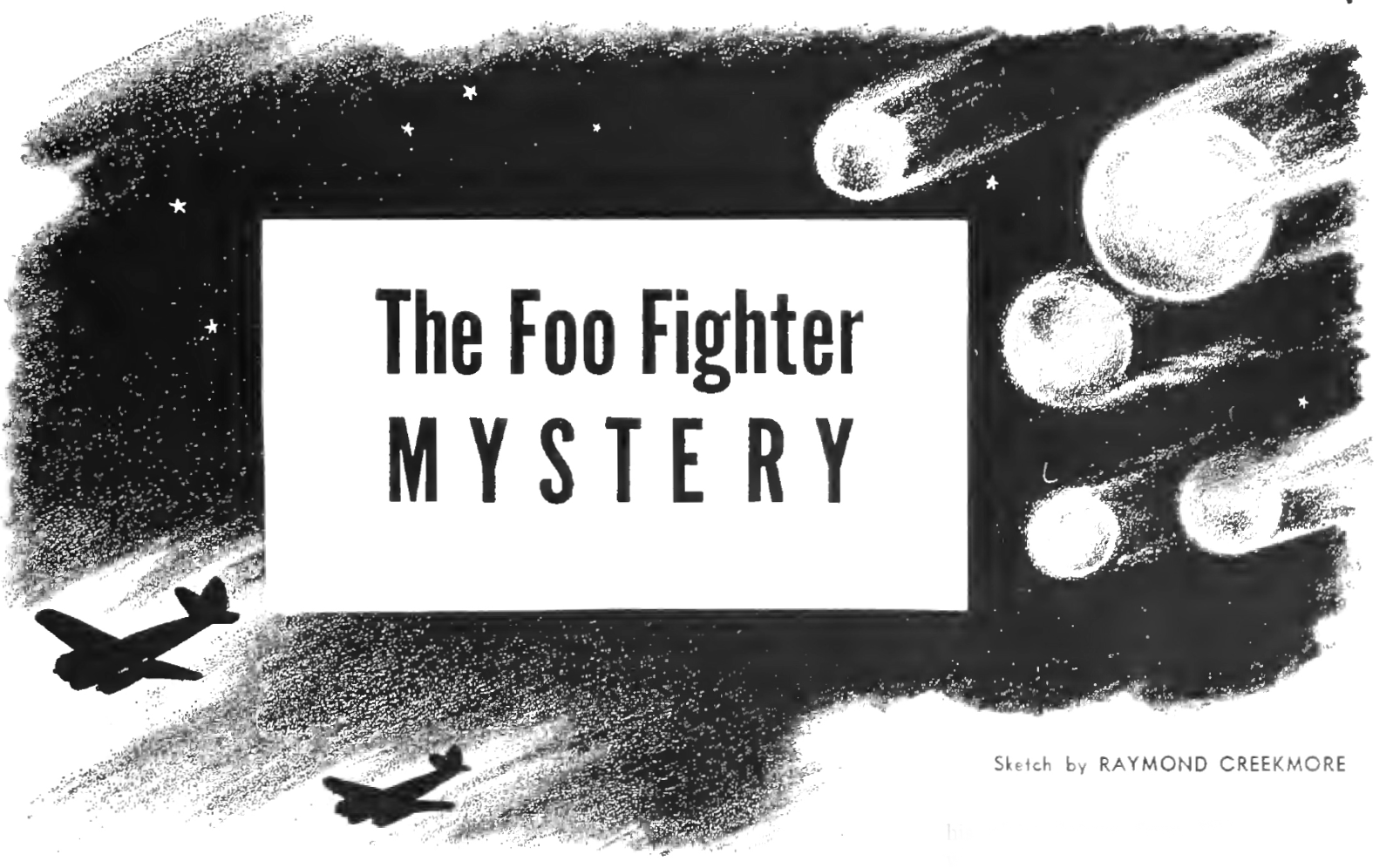
The FOO Fighter Mystery
- August 24, 2017
- 0
By Jo Chamberlin
(Originally Published American Legion Magazine December 1945)
DURING THE last months of the war the crews of many B-29s over Japan saw what they described as “balls of fire” which followed them, occasionally came up and almost sat on their tails, changed color from orange to red to white and back again, and yet never closed in to attack or crash, suicide-style.
One B-29 made evasive maneuvers inside a cloud. but, when the B-29 emerged from it, the ball of fire was following in the same relative position. It seemed 500 yards off, three feet in diameter, and had a phosphorescent orange glow. No wing or fuselage suggesting an aerial bomb or plane was seen. The ball of fire followed the 13-29 for several miles and then disappeared just as mysteriously as it had appeared in the dawn light over Fujiyama.
Some B-29 crews said they could readily lose the ball of fire by evasive maneuvers, even though the ball kept up with them at top speed on a straight course; other B-29 crews reported just the opposite.
Nobody could figure it out.
Far to the south, a B-24 Liberator was at 11.ooo feet over Truk lagoon, when two red lights rose rapidly from below and followed the B-24. After an hour, one light turned back. The other kept onsometimes behind, sometimes alongside, sometimes ahead about 1ooo yards, until daybreak when it climbed up to 75,000 feet and stayed in the sun, like a Japanese fighter seeking game. but never came down. During the flight, the light changed from red to orange. then “·bite, and back to orange, and appeared to be the size of a basketball. No wing or fuselage was observed. The B-24 radioed island radar stations to see if there were any enemy planes in the sky.
The answer was “None.”
A curious business, and one for which many solutions have been advanced before the war was over, and since. Xone of them stand up. The important point is the B-29 was harmed by the balls of fire, although what the future held, no one knew. The Japanese were desperately trying to bolster up their defense in every way possible against air attack, but without success. Our B-29s continued to rain destruction on Japanese military targets, and finally dropped the atomic bomb.
Naturally, U.S. Army authorities in Japan will endeavor to find the secret-but it may be hidden as well as it appears to be in Europe. The balls of fire continue to be a mystery-just; is they were when first observed on the other side of the worldoYer eastern Germany.
This is the way they began.
At ten o’clock of a November evening, in late 1944, Lt. Ed Schlueter took off in his night fighter from Dijon, France. on what he thought would be a routine mission for the 415th Night Fight Fighter Squadron.
Lt. Schlueter is a tall, competent young pilot from Oshkosh, Wisconsin whose hazardous job was to search the night sky for German planes and shoot them down. He had done just this several times and had been decorated for it. As one of our best night fighters, he was used to handling all sorts of emergencies.
With him was radar observer was Lt. Donald T. Meier, and Lt. Fred Ringwald, intelligence officer of the 415th, who flew as an observer.
The trio began their search pattern, roaming the night skies on either side of the Rhine River north of Strasbourg, for centuries the abode of sirens. dwarfs. gnomes, and other supernatural characters, that appealed strongly to the dramatic sense of the late A. Hitler. However, at this stage of the European war, the Rhine was no stage but a grim battleground. where the Germans were making their last stand/
The night was reasonably quiet with no clouds and a quarter moon. There was fair visibility.
In some respects, a night fighter plane operates like a champion boxer whose eye sight isn’t very good; he must rely on other senses to guide him to his opponent. The U.S. Army has ground radar stations, which track all planes across the sky. and tell the night fighter the whereabouts of any plane. The night fighter flies there closes in by means of his own radar until usually, he can see the enemy, and if the plane doesn’t identify itself as friendly he’ll shoot it down.
Or, gets shot down himself, for the Germans operate their aircraft in much the same way we did, and so did the Japanese.
Lt. Schlueter was flying low enough so that he could detect the white steam of a blacked-out locomotive or the sinister bulk of a motor convoy, but he had to avoid smokestacks, barrage balloons, enemy searchlights, and flak batteries. He and Ringwald were on the alert, for there were mountains nearby.
The inside of the plane was dark, for good night vision.
Lt. Ringwald said, “I wonder what those lights are, over there in the hills.”
“Probably stars,” said Schlueter, knowing from long experience that the size and character of lights are hard to estimate at night.
“No, I don’t think so.”
“Are you sure it’s no reflection from us?” “I’m positive.”
Then Ringwald remembered – there weren’t any hills over there. Yet the. “lights” were still glowing-eight or ten of them in a row-orange balls of fire moving through the air at a terrific speed.
Then Schlueter saw them far off his left wing.’Were enemy fighters pursuing him? He immediately checked by radio with Allied ground radar stations.
“Nobody up there but yourself,” they reported. “Are you crazy?”
And no enemy plane showed in Lt. Meiers’ radar.
Lt. Schlueter didn’t know what he was facing-possibly some new and lethal German weapon-but he turned into the lights, ready for action. The lights disappearedthen reappeared far off. Five minutes later they went into a flat glide and vanished.
The puzzled airmen continued on their mission and destroyed seven freight trains behind German lines. When they landed back at Dijon, they decided to do what any other prudent soldier would do-keep quiet for the moment. If you tried to explain everything strange that happened in a war, you’d do nothing else. Further, Schlueter and Meiers had nearly completed their required missions and didn’t want to chance being grounded by some skeptical flight surgeon for “combat fatigue.”
Maybe they had been “seeing things.” But a few nights later, Lt. Henry Giblin, of Santa Rosa, California, pilot. and Lt. Walter Cleary, of Worcester, 1Iassachusetts, radar-observer, were flying at r.ooo feet altitude when they saw a huge red light 1,ooo feet above them, mo,·ing at 200 miles per hour. As the observation was made on an early winter evening. the men decided that perhaps they had eaten something at chow that didn’t agree with them and did not rush to report their experience.
On December 22-23, 1944, another 415th night fighter squadron pilot and radar-observer were flying at 10.000 feet altitude near Hagenau. “At 0600 hours we saw two lights climbing toward us from the ground.
Upon reaching our altitude. they leveled off and stayed on my tail. The lights appeared to be large orange glows. After staying with the plane for two minutes, they peeled off and turned away flying under perfect control, and then went out.”
The next night the same two men. flying at 10,000 feet, observed a single red flame. Lt. David L. Falls, of Cliffside N. C., pilot, and Lt. Ned Baker of Bernat, California, radar-observer, also saw:
“A glowing red object shooting straight up, which suddenly changed to a view of an aircraft doing a wing-over, going into a dive and disappearing.” This was the first and only suggestion of a controlled flying device.
By this time, the lights were reported by all members of the 415th who saw them. Most men poked fun at the observers until they saw for themselves. Although confroted with a baffling situation, and one with lethal potentialities. the 415th continued its remarkable combat record. When the writer of this article visited and talked with them in Germany. he was impressed with the obvious fact that the 415th fliers were very normal airmen, whose primary interest was combat. and after that came pinup girls, poker, doughnuts, and the derivatives of the grape.
The 415th had a splendid record.
The whole outfit took the mysterious lights or balls of fire with a sense of humor. Their reports were received in some higher quarters with smiles: “Sure, you must have seen something, and have you been getting enough sleep?” One day at chow a 415th pilot suggested that they give the lights a name. A reader of the comic strip “Smokey Stover” suggested that they be called “foofighters,” since it was frequently and irrefutably stated in that strip that “Where there’s foo, there’s fire.”
The name stuck.
What the 415th saw at night was born out in part by day. West of Neustadt, a P-47 pilot saw “a gold-colored ball, with a metallic finish, which appeared to be moving slowly through the air. As the sun was low, it was impossible to tell whether the sun reflected off it, or the light came from within.” Another P-47 pilot reported “a phosphorescent golden sphere, 3 to 5 feet in diameter, flying at 2,000 feet.”
Meanwhile, official reports of the “foofighters” had gone to group headquarters and were “noted.” Now in the Army, when you “note” anything it means that you neither agree nor disagree, nor do you intend to do anything about it. It covers everything. Various explanations were offered for the phenomena–‘-none of them satisfactory, and most of them irritating to the 415th.
It was said that the foo-fighters might be a new kind of flare.
A flare, said the 415th, does not dive, peel off, or turn.
Were they to frighten or confuse Allied pilots?
Well, if so, they were not succeeding and yet the lights continued to appear.
Eighth Air Force bomber crews had reported seeing silver-colored spheres resembling huge Christmas tree ornaments in the sky-what about them?
Well, the silver spheres usually floated, and never followed a plane. They were presumably some idea the Germans tried in the unsuccessful effort to confuse our pilots or hinder our radar bombing devices.
What about jet planes?
Ko. the Germans had jet planes all right, but they didn’t have an exhaust flame visible at any distance.
Could they be flying bombs of some sort, either with or without a pilot? Presumably not – with but one exception no one thought he observed a wing or fuselage.
Weather Balloons?
No, the 415th was well aware of their behavior. They ascended almost vertically, and eventually burst.
Could the lights or balls of fire be the red, blue, and orange colored flak bursts that Eighth Air Force bomber crews had reported?
It was a nice idea, said the 415th, but there was no correlation between the foofighters they observed and the flak they encountered. And night flak was usually directed by German radar, not visually.
In short, no explanation stood up.
On Dec. 3 I, I 944, AP reporter Bob Wilson, was with the 415th and heard about the foo-fighters. He questioned the men until 4 a.m. in the best newspaper tradition until he got all the facts. His story passed the censors, and appeared in American newspapers on January 1st, 1945, just in time to meet the customary crop of annual hangovers.
Some scientists in New York decided, apparently by remote control, that what the airmen had seen in Germany was St. Elmo’s light-a well-known electrical phenomenon appearing like light or flame during stormy weather at the tips of church steeples, ships’ masts, and tall trees. Being in the nature of an electrical discharge, St. Elmo’s fire is reddish when positive, and blueish when negative.
The 415th blew up. It was thoroughly acquainted with St. Elmo’s fire. The men snorted. “Just let the sons come over and fly a mission with us. We’ll show ’em.”
Through January, 1945, the 415th continued to see the “foo-fighters,” and their conduct became increasingly mysterious. One aircrew observed lights, moving both singly and in pairs. On another occasion, three sets of lights, this time red and white in color, followed a plane, and when the plane suddenly pulled up, the lights continued on in the same direction, as though caught napping, and then sheepishly pulled up to follow.
The pilot checked with ground radarhe was alone in the sky.
This was true in every instance foofighters were observed.
The first real clue came with the last appearance of the exasperating and potentially deadly lights. They never kept the ‘ 415th from fulfilling its missions, but they certainly were unnerving. The last time the foo-fighters appeared, the pilot turned into them at the earliest possible momentand the lights disappeared. The pilot was sure that he felt prop wash, but when he checked with ground radar, there was no other airplane.
The pilot continued on his way, perturbed, even angry-when he noticed the lights far to the rear. The night was clear, and the pilot was approaching a huge cloud. Once in the cloud, he dropped down two thousand feet and made a 30 degree left turn. Just a few seconds later he emerged from the cloud-with his eye peeled to the rear. Sure enough, coming out of the cloud in the same relative position was the foofighter. as though to thumb its nose at the pilot, and then disappear.
This was the last time the foo-fighters were seen In Germany, although it would have seemed fitting, if the lights had made one last gesture, grouping themselves so as to spell “Guess What” in the sky, and then vanishing forever.
But they didn’t.
The foo-fighters simply disappeared when Allied ground forces captured the area East of the Rhine. This was known to be the location of many German experimental stations. Since V-E day our Intelligence officers have put many such installations under guard. From them we hope to get valuable research information-including the solution to the foo-fighter mystery, but it has not appeared yet. It may be successfully hidden for years to come, possibly forever.
The members of the 415th hope that Army Intelligence will find the answer. If it turns out that the Germans never had anything airborne in the area, they say, “We’ll be all set for Section Eight psychiatric discharges.”
Meanwhile, the foo-fighter mystery continues unsolved. The lights, or balls of fire, appeared and disappeared on the other side of the world, over Japan-and your guess as to what they were is just as good as mine, for nobody really knows.



